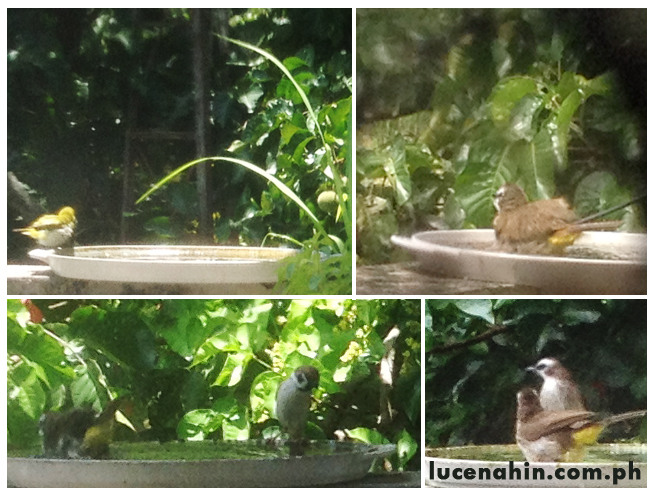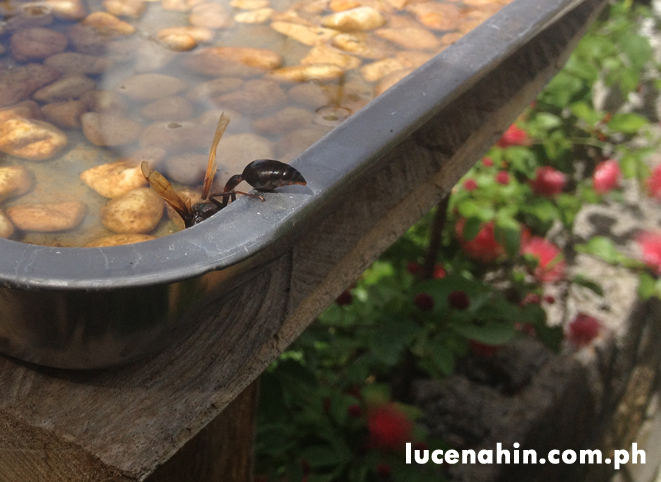A Water Dish and Bird Baths in the Garden
It’s 32 degrees Celsius in Lucena, this Saturday afternoon of May. It looks really hot outside and a glass of ice cold water sounds very nice.
Before sitting in my computer, I caught a glimpse of a young bird, a Eurasian Sparrow, staring curiously at the water dish in my balcony. Another bird soon came, a Yellow-vented Bulbul, and it went straight to the dish like it’s part of his daily routine and started taking a bath.
Providing water can certainly help birds especially during summer. With news of climate change and various environmental problems, this is one of the many ways we can help wildlife.
Bird baths are very easy to set up and to maintain. I started installing mine last year and it became a joy to watch whenever I see birds use it. Here are some mobile photos I was able to take while quietly hiding behind our screened door:
It was pretty exciting when I saw 3 different bird species using one water dish all at the same time – a Eurasian Sparrow, a Yellow-vented Bulbul and a Lowland White-eye. How cool is that?
After making sure that the water dish is being used, I placed a few more around the garden. Soon enough, I was able to take a photo of a wasp (probably a Black Potter Wasp) that I found drinking from it every morning.
Setting up a Water Dish / Bird Bath
Location. You need to decide where to place your bird bath. It needs to be somewhat isolated so that the birds can see if there are any predators around. It should also be near tree branches so they can escape easily especially when they are wet. You also need to find a shady area so the water won’t get too warm. Although, I still maintain one bird bath under full sun the whole day. You will just have to keep refilling it twice daily. You should also have easy access to water so it is easy to clean and refill. And in case you don’t, like mine in another part of the garden, I keep a 5-liter water bottle under for refilling. And of course, it is also nice to put your bird bath where you can also see it.
Materials. There are readily available bird baths for sale in garden shops, most of them though are too deep for birds to use. If you prefer the look of these bird baths, you can add stones so that the deepest part is only about 3 inches and it should have shallow edge. The bottom should also be rough so they won’t lose their footing. A solar powered fountain sounds nice too, although I’m not sure if we have them here in Lucena.
You might also want to use what’s readily available and only buy when you need to. For the water dish in my balcony, I used an old plastic food tray and tiny pebbles because of the smooth bottom. And for the other bird baths we placed in our garden, I used stainless trays with large pebbles and placed them on top of wooden pedestals we made from wood scraps that we have in the garden. Don’t forget to add a larger piece of stone to create a very shallow water portion so tiny bugs can also drink without drowning.
Maintenance
After you’ve set up your water dish/bird bath, add water daily or every other day. Make it part of your routine when you water your plants. I let the water flow outside the water dish. The plants underneath catch the overflow water so it’s not wasted.
Be sure to clean them every week or so or right then when you find mosquito larvae. The pebbles make it a little harder to clean than a cemented bird bath so you might want to consider that. We use organic soap to clean them sometimes but usually a scrubbing pad and water is enough. If you use soap (organic or not), let the bird bath dry out before refilling. You can use natural cleaners like baking soda and vinegar as well.



 Philippine Peso
Philippine Peso